SOFTWARE

HIPERPAV is used by planners, designers, contractors, and suppliers for a variety of purposes. During the planning stage, HIPERPAV can be used to develop quality control specifications based on the available materials and local climatic conditions. Pavement designers use HIPERPAV to optimize the design variables and guarantee long-term performance while maximizing economy. Contractors use HIPERPAV to prevent expensive repairs by predicting potential damage and determining how to prevent it. With HIPERPAV, suppliers manage the temperature of the concrete based on their mix designs and specific climate and project conditions.
HIPERPAV was developed by Transtec and the FHWA after completing a research project modeling the early-age development of concrete strength and stresses resulting from moisture and temperature changes within the pavement.
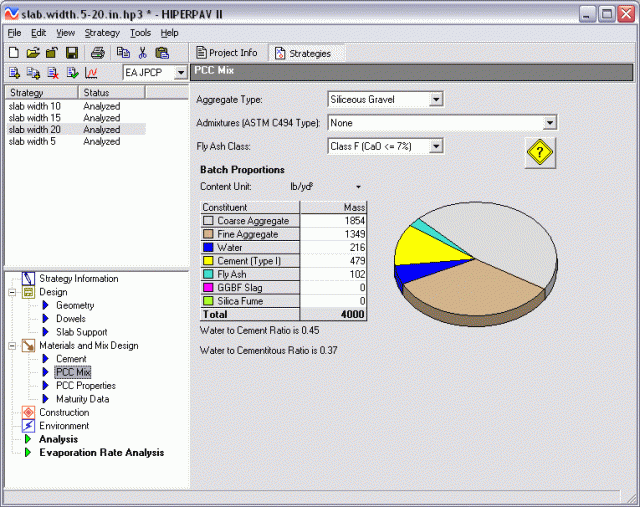
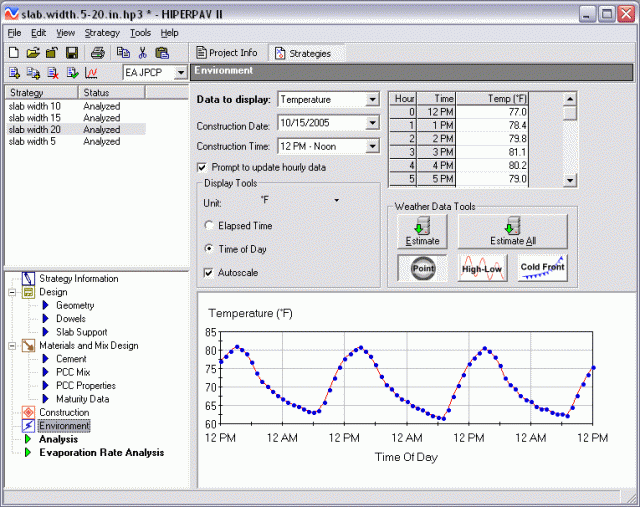
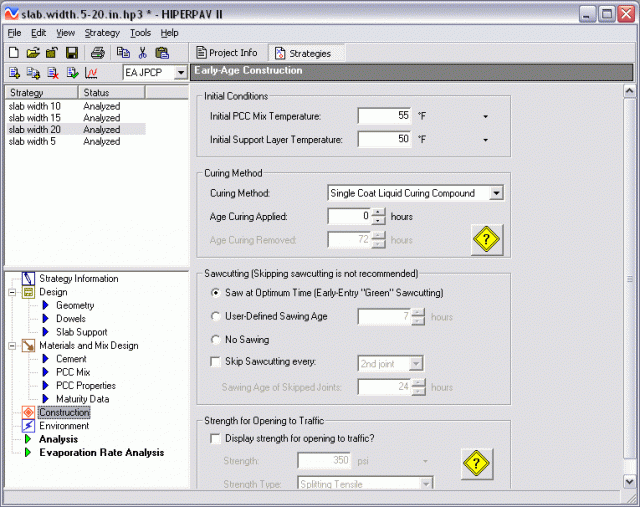
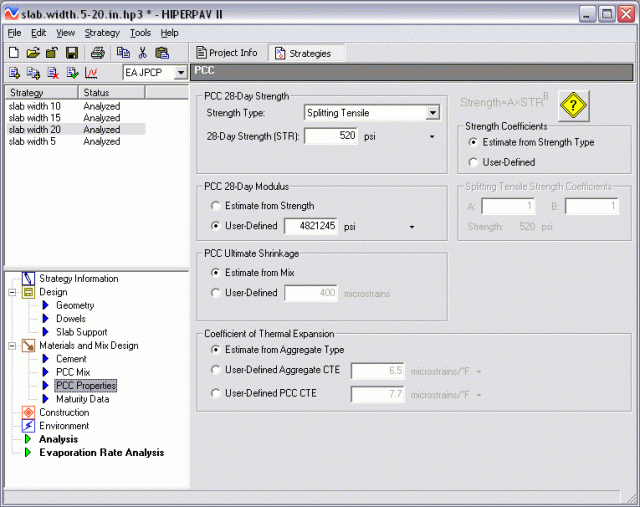
The service life of concrete pavements is highly dependent upon their early age behavior. Portland cement concrete pavements (PCCP) are significantly affected by temperature and moisture changes during the first 72 hours following placement.
Stresses in the concrete build up primarily due to the combined effects of curling and warping and restraint to axial movements at the slab-subbase interface. These stresses may be of sufficient magnitude to cause cracking because concrete strength is relatively low during this “early-age” period.
Monitoring of the stresses during this time is extremely important since problems during this early-age may lead to loss of pavement performance in the long term. A pavement designed for a life of 30-years, for example, may only last 10-years if problems occur during this critical early-age period. Conversely, if no problems occur during this period, the pavement may exceed the intended design life, resulting in an overall cost-savings.
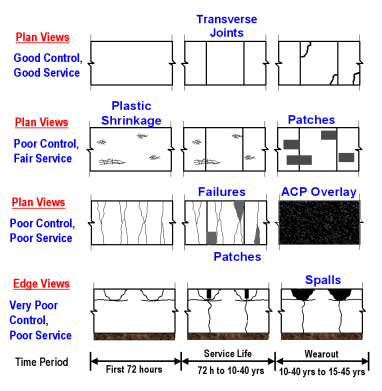
With HIPERPAV, you can input everything you know about a concrete project – mix design, joint design, subbase type, curing method, weather conditions, sawcut timing, everything – and accurately predict the stress and strength behavior of the concrete over the first critical 72 hours.
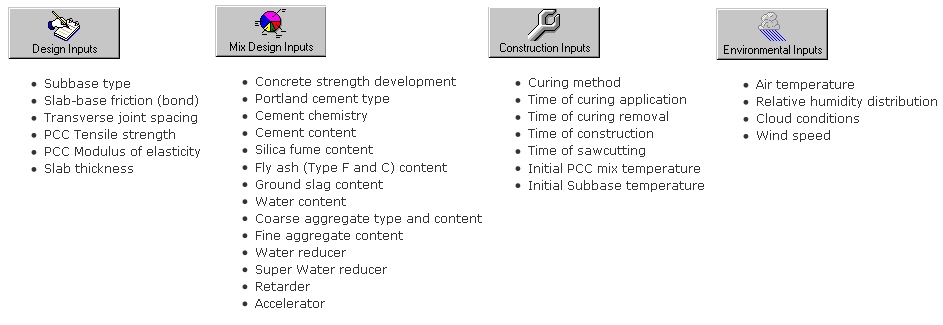
Over the course of its development, each of the models in HIPERPAV have been individually calibrated.
In fact, the FHWA recently completed an extensive validation of HIPERPAV for a range of design, materials and climatic conditions for several sites in the United States. The validation process included the instrumentation of pavements under construction with the objective to study how those pavements behave at early-ages and verify the accuracy of HIPERPAV in predicting the stresses, concrete strength development, and crack susceptibility of concrete pavements during the first 72 hours after placement.
The validation results demonstrated an excellent predictive capability of HIPEPRAV for the overall early age behavior. In general, it was observed that the numerous models in HIPERPAV predict well the early-age behavior of pavements under different design, material, construction and climatic conditions. The overall system was found to predict crack formation with an accuracy of approximately 5 hours. This is considered a reasonable approximation and is easily accounted for by the variability in each of the factors affecting stresses and strength.
The states in which full-scale validation was performed included Minnesota, Nebraska, Arizona, Texas, and North Carolina. The highway departments in each of these states have been cooperative and instrumental in the success of this phase.
Field Data Collection, Instrumentation, and Testing
The input data needed for the HIPERPAV software was carefully collected, namely, the pavement design, concrete materials, environmental conditions and construction methods. In addition, slabs were instrumented with gages to measure the strains and deflections of the pavement during the first 72 hours after placement.
A list of the devices and field tests used to collect data in these field sites are:
Data was also gathered in the laboratory to obtain the concrete’s material properties:
Then, the experimentally measured stresses generated in the concrete pavement could be compared to the predicted ones generated by the HIPERPAV software. This validation was performed to increase user confidence in the accuracy of the HIPERPAV program.
Reports
McCullough, B.F. and Rasmussen, Robert Otto, “Fast-Track Paving: Concrete Temperature Control and Traffic Opening Criteria for Bonded Concrete Overlays Volume I: Final Report,” Federal Highway Administration Report FHWA-RD-98-167, Washington, 1999.
McCullough, B.F. and Rasmussen, Robert Otto, “Fast-Track Paving: Concrete Temperature Control and Traffic Opening Criteria for Bonded Concrete Overlays Volume II: HIPERPAV User’s Manual,” Federal Highway Administration Report FHWA-RD-98-168, Washington, 1999.
Rasmussen, Robert Otto, et. al., “Fast-Track Paving: Concrete Temperature Control and Traffic Opening Criteria for Bonded Concrete Overlays Volume III: Addendum to the HIPERPAV User’s Manual,” Federal Highway Administration Report FHWA-RD-99-200, Washington, 1999.
J. Mauricio Ruiz, Robert O. Rasmussen, George K. Chang, Jason C. Dick, Patricia K. Nelson, Ted R. Ferragut, “Computer-Based Guidelines for Concrete Pavements Volume I-Project Summary,” Federal Highway Administration Report FHWA-HRT-04-121, Washington, September 2004.
J. Mauricio Ruiz, Robert O. Rasmussen, George K. Chang, Jason C. Dick, Patricia K. Nelson, “Computer-Based Guidelines For Concrete Pavements Volume II-Design and Construction Guidelines and HIPERPAV II User’s Manual,” Federal Highway Administration Report FHWA-HRT-04-122, McLean, VA, January 2005.
J. Mauricio Ruiz, Robert O. Rasmussen, George K. Chang, Jason C. Dick, Patricia K. Nelson, Anton K. Schindler, Dennis J. Turner, W. James Wilde, “Computer-Based Guidelines For Concrete Pavements Volume III-Technical Appendices,” Federal Highway Administration Report FHWA-HRT-04-127, McLean, VA, September 2005.
Other Documents
Case Studies
Cement Type
Cold Front Scenario
Coefficient of Thermal Expansion
Mid-Panel Cracking
Sawcutting Schedule
Faulting
Time of Placement
Aggregate Selection
Temperature Fluctuation
CONTACT US

The Transtec Group engineers the best pavements in the world. Have a pavement problem? Give us a call—we’re good listeners.
© 2025 | The Transtec Group, Inc. | Privacy Policy